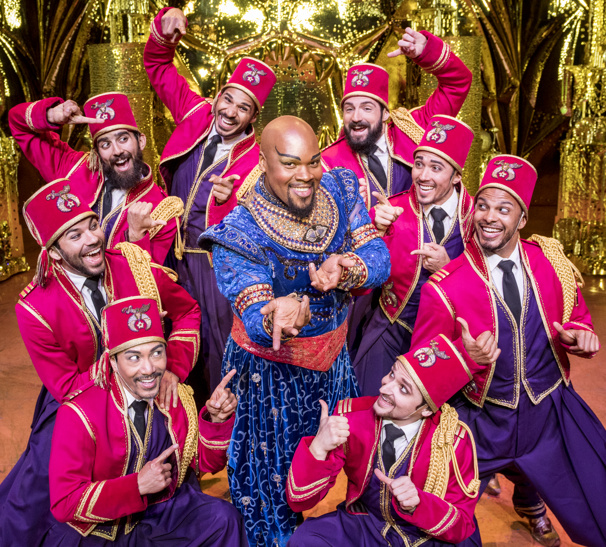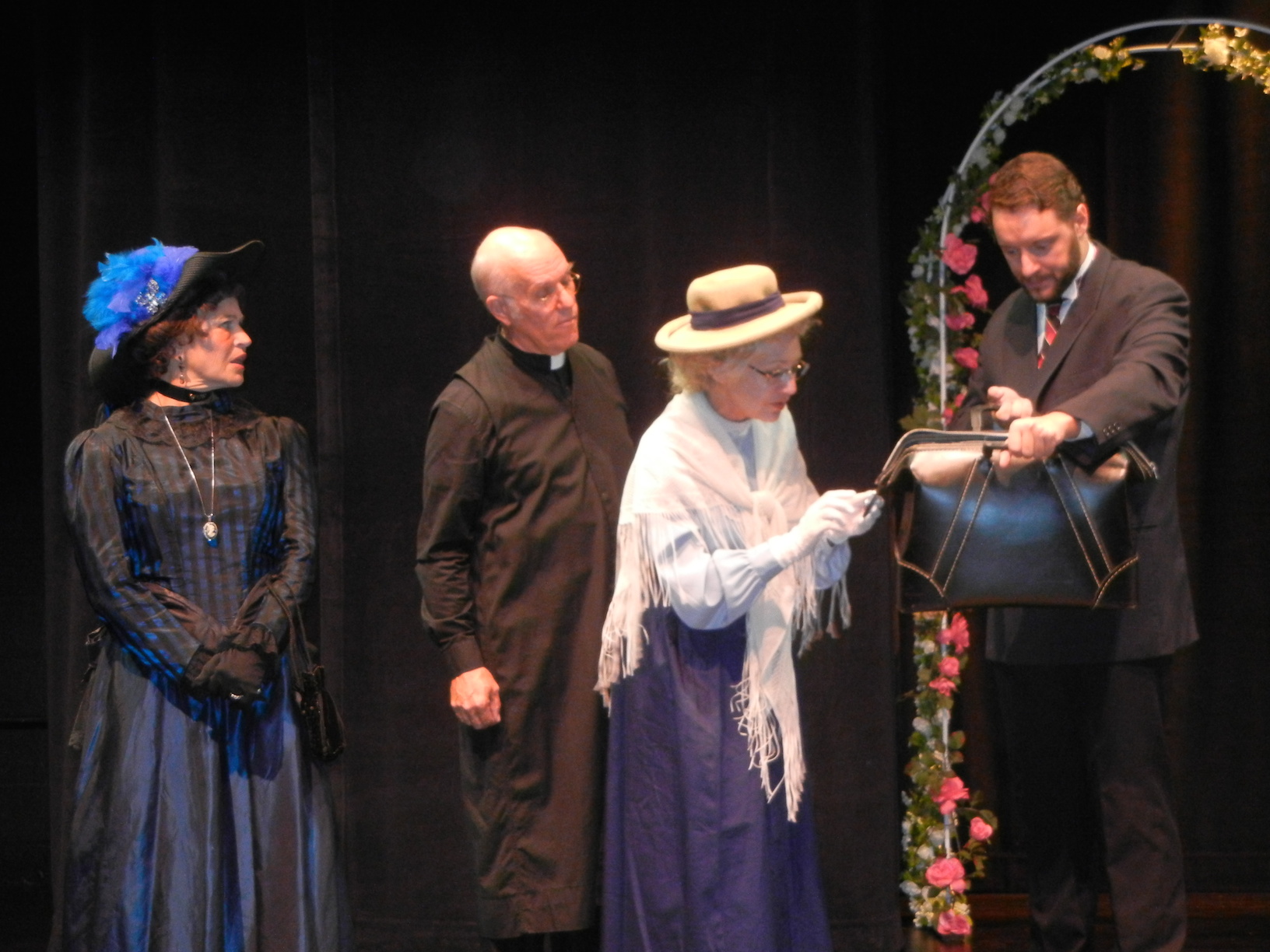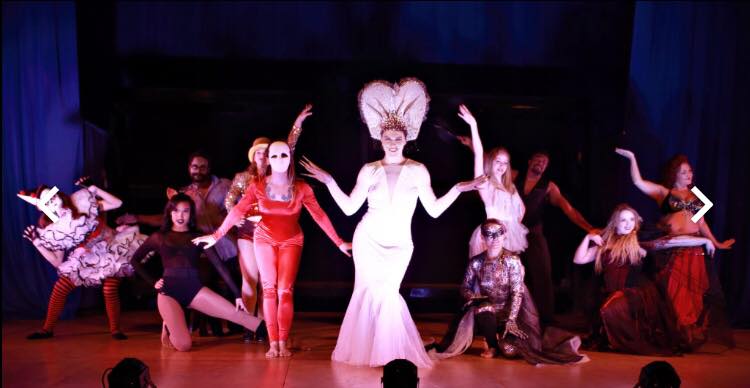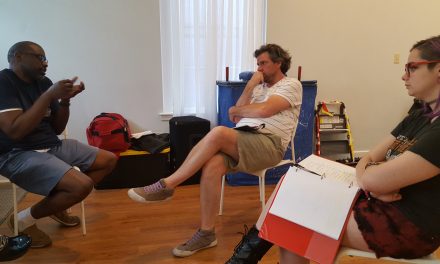Michael James Scott. Photo: Deen Van Meer
Disney’s Aladdin
Music by Alan Mencken, Lyrics by Howard Ashman & Tim Rice
Book by Chad Beguelin
Directed by Casey Nicholaw
Review by Kathi E.B. Ellis
Entire contents are copyright © 2018 by Kathi E.B. Ellis. All rights reserved.
After the disappointment of canceling Waitress following the June 13 fire at the Kentucky Center, Broadway in Louisville kicks off the current season in spectacular style. The 2014 Broadway production of Disney’s Aladdin flew into Louisville this week for an extended run.
The Lion King will always be a high point for me in musical theatre creativity, but Disney Theatre Productions (again) comes close with Aladdin’s lavishly technological interpretation of the magic that is possible in an animated movie.
And so, let’s start with the spectacle, which abounds throughout the two and a half hour running time.
Bob Crowley, whose scenic design frequently embraces lush, positively exudes color and excess in this production. From the highly saturated desert-influenced colors of the marketplace to the cool elegance and intricate carvings of the palace, the environments continuously beg for the audience to suspend disbelief. And gloriously so in the magic cave where Aladdin discovers both the magic lamp and the Genie.
Costume designer Gregg Barnes is definitely a co-conspirator in the realm of lush. Costumes pay exotic homage to several cultures, and sequins and sparkle are a staple in this fanciful world of Agrabah. Natasha Katz’ lighting and judiciously used projections complete the holistic visuals. And, of course, the illusion of the magic carpet, provided by Jim Steinmeyer, is paramount.
That illusion, of Aladdin (Clinton Greenspan) and Jasmine (Lissa deGuzman) floating through the night sky does indeed suspend disbelief. It’s a moment of tranquility in an otherwise fast-paced evening. In absolute contrast, the appearance of the Genie in the gold-swathed cave, and the seemingly-never-ending, fast-paced costume changes of his acolytes in the show-stopping “Friend Like Me” are both sumptuous and technically impressive.
How do the characters fare in this exuberant, ever-changing, swirling environment?
As in the movie, despite the title of the show, in large part, this production belongs to the Genie. And Michael James Scott does not disappoint. He won the prestigious Helpmann Award when he originated this role in Australia, and he inhabits this character with aplomb. From his beginning narration through some nifty moves and his free-form stand-up comedy-informed riffs he commands the stage physically and vocally.
Not everything translates from screen to stage, from animation to three dimensions. Gone are Abu and Rajah, the animal sidekicks of Aladdin and Jasmine. Aladdin fares better in the stage version, acquiring a gaggle of street kids to support him – Babkak, Omar, and Kassim (endearingly played by Zach Bencal, Philippe Arroyo, and Jed Feder respectively.) They give Aladdin a sounding board which allows him to appear more complex than Jasmine. Greenspan, who has a lyric quality to his singing, captures Aladdin’s devil-may-care attitude and also finds a few moments of reflection and self-discovery (despite Jafar’s admonition that there is no time for this) which flesh out his character.
Jasmine, in contrast, is given three servants who are seen briefly and are not permitted substantive dialogue (Bechdel is far from present,) resulting in Jasmine’s character being much more of a cipher than that of the sassy animated character. DeGuzman brings a beautiful voice to the performance but doesn’t manage to get beyond two dimensions with her character. This is unfortunate because the ensemble females are in the show merely for ornamentation, and as referred to above, Jasmine has no foil for any independent ideas; thus her few comments about what she wants seem more about a petulant, privileged child and less about a strong young woman who truly can take the reins of the sultanate equally with her husband, as her father decrees at the end.
Jafar (Jonathan Weir) and Iago (the one animal-inspired side-kick who survives the adaptation,) played by Jay Paranada, clock in as typical larger-than-life Disney villains throughout the evening. Their outsize villainy is grounded in authentic desires, which lift their characters from the merely two-dimensional. The feckless palace guards who are deployed to catch Aladdin and generally do the dirty work, fare less well. On Thursday night their energy was low and for much of the early choreography, they seemed to be ‘going through the motions’ which detracted from the intricacy of the marketplace chase scene.
The music by Alan Menken takes us through a wide range of references – musical theatre, American popular culture, and nods to vaguely Middle Eastern influences. The Aladdin touring orchestra under the baton of Brent-Alan Huffman kept the energy and tempo flying, while also finding the quieter lyric moments.
Aladdin is in Louisville for a longer run than many Broadway in Louisville shows. If the opening night attendance is anything to go by, the Whitney will be jam-packed for this sumptuous spectacle. If you grew up with the movie, you’ll find plenty of things to enjoy (and a few that you’ll miss) and if you want to introduce the next generation to this fairy tale, this is a great introduction to Broadway magic for the young and young at heart.
Disney’s Aladdin
October 10 – 21, 2018
PNC Broadway In Louisville
Kentucky Center for the Performing Arts
501 West Main Street
Louisville, KY 40204
502-584-7777
louisville.broadway.com
Kathi E.B. Ellis is an associate member of the Stage Directors and Choreographers Society and a member of Lincoln Center and DirectorsLabChicago. She has attended the La MaMa Directing Symposium in Umbria, Italy and is featured in Southern Artisty, an online registry of outstanding southern artists. Her directing work has been recognized with nominations for South Florida theatre’s Carbonell Award. Locally, Kathi is a member of Looking for Lilith Theatre Company, a founding principal of StageLab theatre training studio, and part of ShoeString Productions, an informal producing collective. She has written book reviews and articles for Southern Theatre, the quarterly publication of the Southeastern Theatre Conference, and was a contributing writer for JCPS’ textbook for the 11th grade Arts and Humanities survey course and for YouthArts Tapestry, a Kentucky Arts Council publication.





